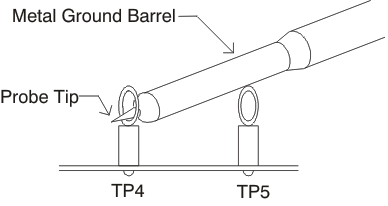SLUU364C May 2009 – January 2022 TPS51315
7.1.4 Oscilloscope
A digital or analog oscilloscope can be used to measure the output ripple. The oscilloscope should be set for 1-MΩ impedance, 20-MHz bandwidth, AC coupling, 2-μs/division horizontal resolution, 20-mV/division vertical resolution. Test points TP4 and TP5 can be used to measure the output ripple voltage. Place the oscilloscope probe tip through TP4 and rest the ground barrel on TP5 as shown in Figure 7-1. Using a leaded ground connection may induce additional noise due to the large ground loop.
 Figure 7-1 Tip and Barrel Measurement for VOUT Ripple
Figure 7-1 Tip and Barrel Measurement for VOUT Ripple